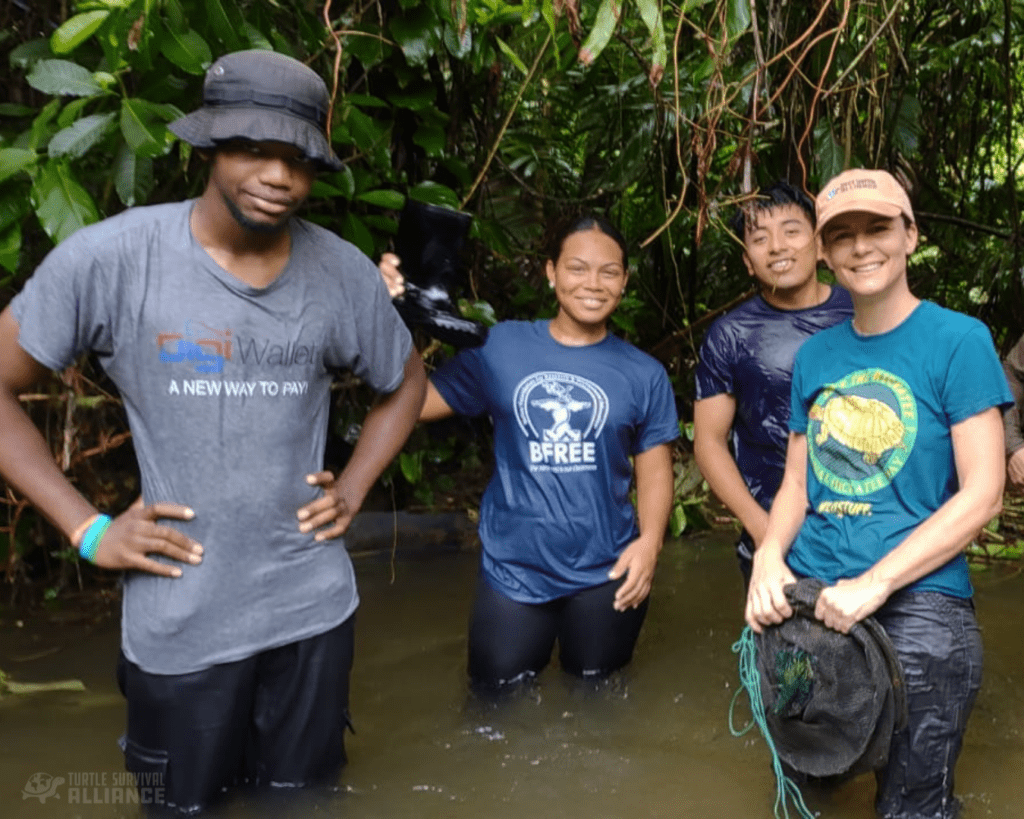From left: Belize Foundation for Research and Environmental Education (BFREE) Science and Education Fellows Heston Castillo, Andrew Choco, and Samih Young in Belize. Andrew holds a Central American River Turtle (Dermatemys mawii), known locally as the “Hicatee”. Photo by Heather Barrett.
An Interview by Rachael Harff, Chelonian Keeper II at the Turtle Survival Center, with BFREE Science and Education Fellows Heston Castillo, Andrew Choco, and Samih Young
During my recent trip to Belize, I had the privilege of meeting Heston Castillo, Andrew Choco, and Samih Young, the current Science and Education Fellows at the Belize Foundation for Research and Environmental Education (BFREE). In honor of Hicatee Awareness Month, and in recognition of the incredible work they’ve done to raise awareness in local communities, we thought it would be fun to share their unique experiences and perspectives on the efforts to protect the critically endangered Central American River Turtle (Dermatemys mawii), or “Hicatee”, as it is known locally. Their insights offer a wonderful glimpse into the passion and dedication driving their important work, while also highlighting the rewards of their efforts and the impact they’re making.
Rachael Harff: How did you first learn about BFREE and get involved with the organization?
Heston Castillo: I first learned about BFREE through a presentation by Jaren Serano, Dermatemys Program Coordinator, at my school. A semester later, I had the opportunity to visit their headquarters, where I was able to get hands-on experience in bird banding, hiking, and learned about various tree species. It was this experience that sparked my interest in BFREE and I wanted to go back, with my interest in trees as one of my main reasons when I first applied.
Andrew Choco: I started hearing about BFREE during my first semester in college. Independence Junior College (IJC) has a strong relationship with BFREE so second-year Natural Resource Management students go for field trips there as a requirement for the course. Hearing other student’s stories sparked my interest. During my 3rd semester, my teacher Mr. Leomar shared a volunteering opportunity for the 2024 Biannual Health Check Assessment with me. I did apply but there was space for just 2 people. Not long after, I was attended a field trip with IJC to the BFREE field station and I got to meet Ms. Heather Barrett, Deputy Director of BFREE, who recognized me from the interview for the volunteer position. The wonderful experience of the place and all the activities we did pushed me to do my required one-month internship there. Upon completing my internship, I was offered the opportunity to work as a summer fellow and later on was offered the two-year work-training position of Wildlife fellow.
Samih Young: I first heard about BFREE through an opportunity to volunteer for the Biannual Health Check Assessment. I applied for the position and was fortunate enough to be selected. During my four days at BFREE, I worked closely with the staff and turtle enthusiasts, gaining hands-on experience and learning a great deal from the team. The experience was incredible, not only because of the amazing people but also due to the rich biodiversity. I had the chance to see some really fascinating wildlife. It was an unforgettable experience that deepened my passion for conservation.
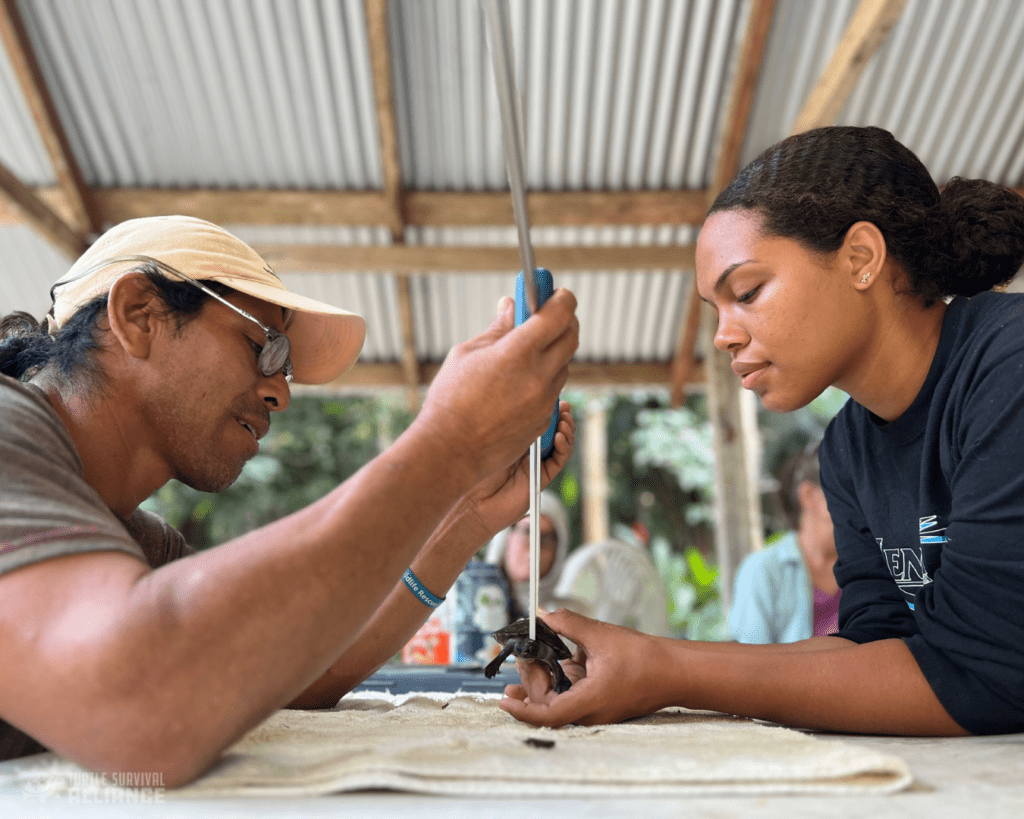
RH: What is your role at BFREE, and what does a typical day look like for you?
HC: My role at BFREE is a bit complex. I am a Cacao fellow, so my role is to assist where needed on the farm and Cacao Discovery Center. However, I also help out with multiple sectors of BFREE: turtles, birds, GPS, data, and just about wherever help is needed. My days are always busy when I’m stationed at BFREE, there is literally something new to learn every day, so a typical day would just be me in the field working and learning at the same time.
AC: Currently, I’m working as a part-time wildlife fellow as I finish my remaining semester in college. I only work at the BFREE base on weekends when staff are in. Upon my graduation In December, I will begin work full-time with BFREE. My focus is primarily on turtles and supporting the work of the Hicatee Conservation and Research Center (HCRC), where data entry and collection play a crucial role. A typical day involves having an open mind, working both remotely and in the field, and contributing to various tasks to ensure the work gets done, allowing me to develop time management and communication skills. Since I work closely with turtles, I often raise awareness about them, and recently, I’ve been doing outreach to schools as part of my efforts to educate young students about turtle conservation.
SY: I am currently working part-time at BFREE while pursuing my bachelor’s degree. My primary role involves assisting with social media, and lately, I’ve been focusing on Hicatee Awareness Month. A typical day is hard to describe since the tasks vary, but recently, I’ve been dedicating a lot of time to giving presentations at different schools and creating educational resources for social media. This variety keeps things exciting and allows me to engage with both the public and the conservation community in meaningful ways.
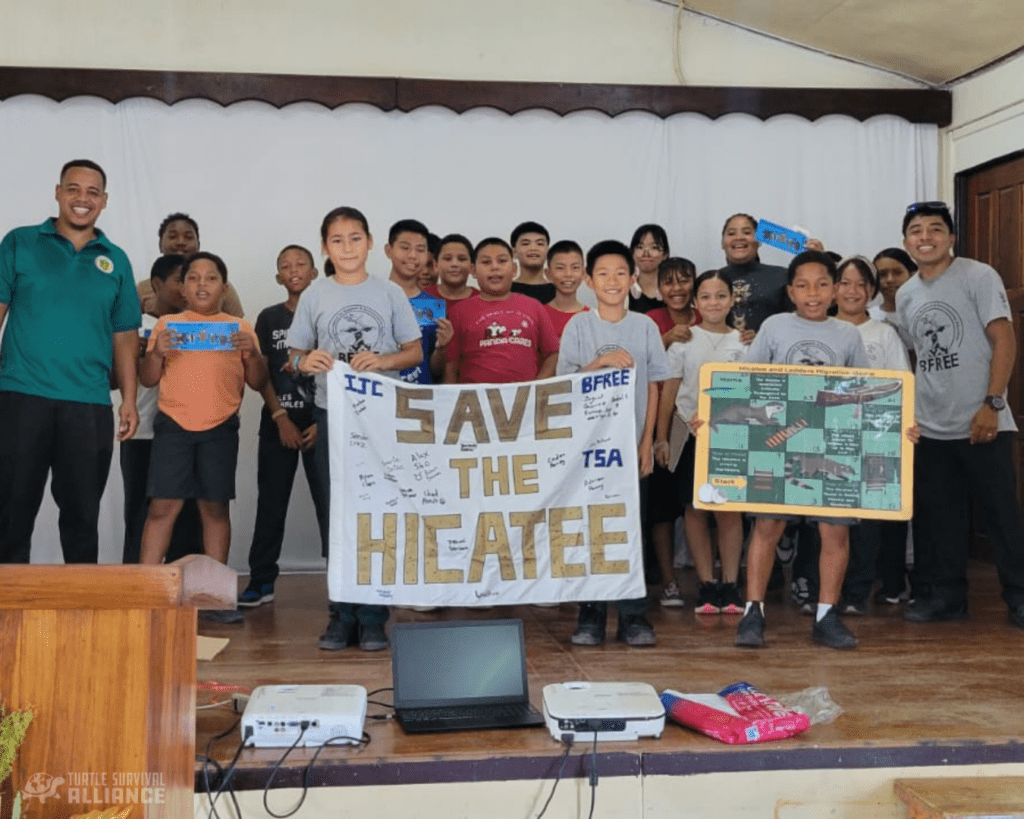
RH: What sparked your passion for conservation, and with turtles in particular?
HC: It wasn’t until I started college, that my teacher, Ms. Ingrid Rodriguez, showed us how important conservation was and taught us almost everything I know today on how to properly interact with the environment. I was an animal lover from day one, and didn’t get to work with turtles until my first few days at BFREE, but when I did, it just felt natural and great.
AC: My passion for conservation began at a young age, sparked by watching Animal Planet. Those early experiences opened my eyes to the beauty of wildlife and the importance of protecting it. As I grew older, this passion deepened, leading me to pursue studies in Natural Resources Management. Working as a Wildlife Fellow at BFREE gave me a hands-on role in conservation, where I discovered my love for turtles, especially the critically endangered Hicatee Turtle. Seeing how vulnerable these creatures are inspired me to dedicate myself to their protection and to raise awareness about their plight. The Hicatee is more than just a species to save; it represents the delicate balance of ecosystems and the need for ongoing conservation efforts.
SY: My passion for conservation goes back to my childhood, growing up I often visited Turneffe Flats. Although I’m originally from Belize City, where conservation isn’t a major focus, but my frequent visits to the Cayes immersed me in nature, where I was surrounded by marine life and animals I loved. From an early age, I knew I wanted to become a marine biologist to protect the incredible species around me, so future generations could experience the same wonder I felt growing up. When I applied to the University of Belize, I chose to study Natural Resource Management which opened my eyes to the beauty and importance of the terrestrial world, just like my connection to the marine environment. My first hands-on experience with turtles came at BFREE, where I worked with Hicatees. I had never seen one in real life before, but I fell in love with them instantly. Learning about their cultural and ecological significance in Belize deepened my passion for conserving this important species.
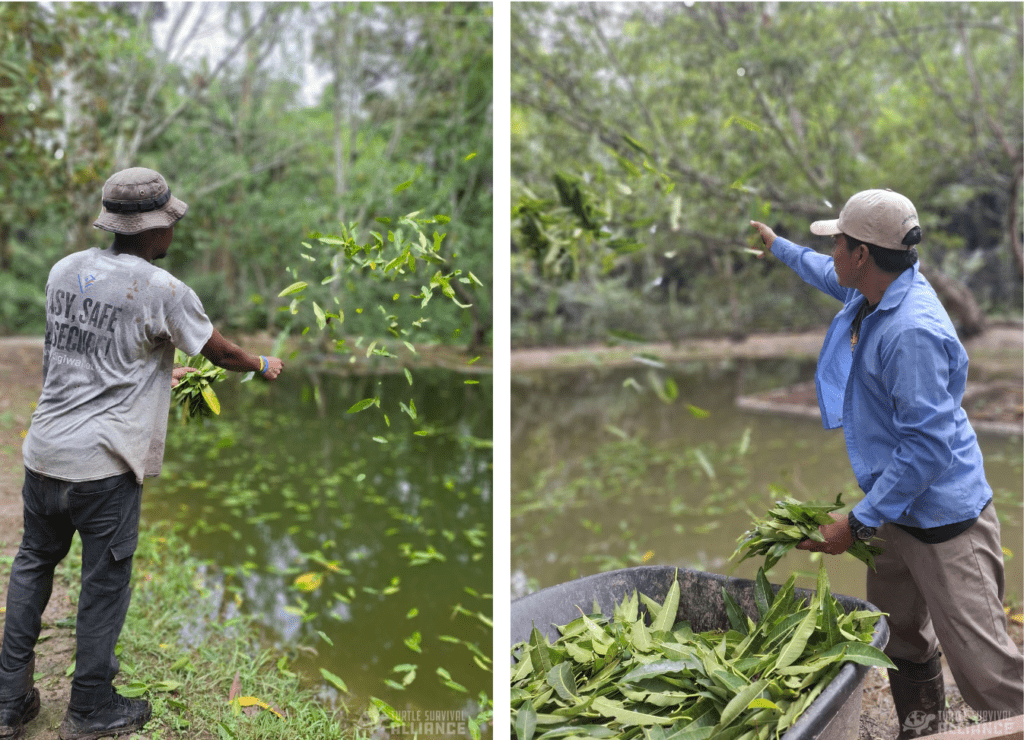
RH: Growing up in Belize, where Hicatee are often considered a delicacy and food source, what was your original perception of them, and how has that changed since you first learned about or became involved with BFREE?
HC: As kids, we would eat these turtles in our community as they were seen as a delicacy in my culture. Since I was so young, I had no control over what I ate. When I started high school, I first became aware that certain species on earth are endangered, and eventually stopped eating these turtles as a whole. When BFREE came in and shared their presentation on the hicatee to our school, it was more of an “I told you so” moment for me as I had already been telling my family that eating endangered turtles is bad.
AC: Growing up in Belize, I actually didn’t know much about Hicatees due to the region I lived in, and eating turtles wasn’t part of my family’s practices. I learned about the Hicatee when I became interested in volunteering at BFREE, which sparked my curiosity and led me to research the species. Getting involved with this organization opened my eyes to the Hicatee’s critical role in our ecosystems and its urgent conservation needs. This experience ignited my passion to protect this species and raise awareness about turtles that are often overlooked.
SY: Growing up in Belize, where Hicatee are considered a delicacy and a traditional food source, I didn’t initially view it as an issue. I remember going to the La Ruta Maya, a popular annual event, where different vendors would sell Hicatee, and it was just a normal part of the culture. People bought and ate it without much thought. However, my perspective changed once I became involved with BFREE and learned about the severe impact this demand is having on the Hicatee population. It became clear to me how unsustainable the current rate of consumption is for the species. The goal isn’t to stop people from eating Hicatee altogether but to help them understand the consequences and support sustainable practices. This ties into the importance of citizen science—engaging communities in conservation efforts so they can be part of the solution.
RH: How frequently do you engage with the general public or students about conservation topics or spreading awareness, and what kind of resources does BFREE provide to local communities to support their involvement in conservation efforts?
HC: I usually promote environmental awareness on social media, as that’s where I get more feedback and as well target a large and diverse audience. BFREE also does this but on a much larger scale, for instance, every October for Hicatee Awareness Month, we go into communities and various schools to promote awareness on the Hicatee. We also promote awareness of other conservation work in general, even beyond Hicatee Awareness Month, and are always sure to include local communities and volunteers.
AC: At school, work, home, or in public, many know me as a passionate conservationist. Many stores no longer offer me plastic bags for my groceries. I constantly educate my family and colleagues about environmental issues and reach a broader audience through my social media by sharing conservation updates. BFREE’s Hicatee Awareness Month initiative, along with workshops, volunteer opportunities, and E-newsletters to teachers, effectively engages the community in conservation efforts, benefiting both the community and the organization.
SY: As the president of the UB Environmental Club, I frequently engage with the public and students on conservation topics through presentations at schools, social media, and organizing forums or symposiums at the university. At BFREE, we also engage the public through various outreach efforts, including social media and presentations tailored to different age groups. For younger students, we use resources like the book Herbert the Hicatee and coloring sheets to make learning about conservation fun and accessible. For older students, we provide more in-depth presentations, along with materials such as T-shirts, posters, and stickers to keep them engaged and involved in the conservation efforts. These resources help us ensure that everyone, regardless of age, feels included in the mission to protect Belize’s natural heritage.
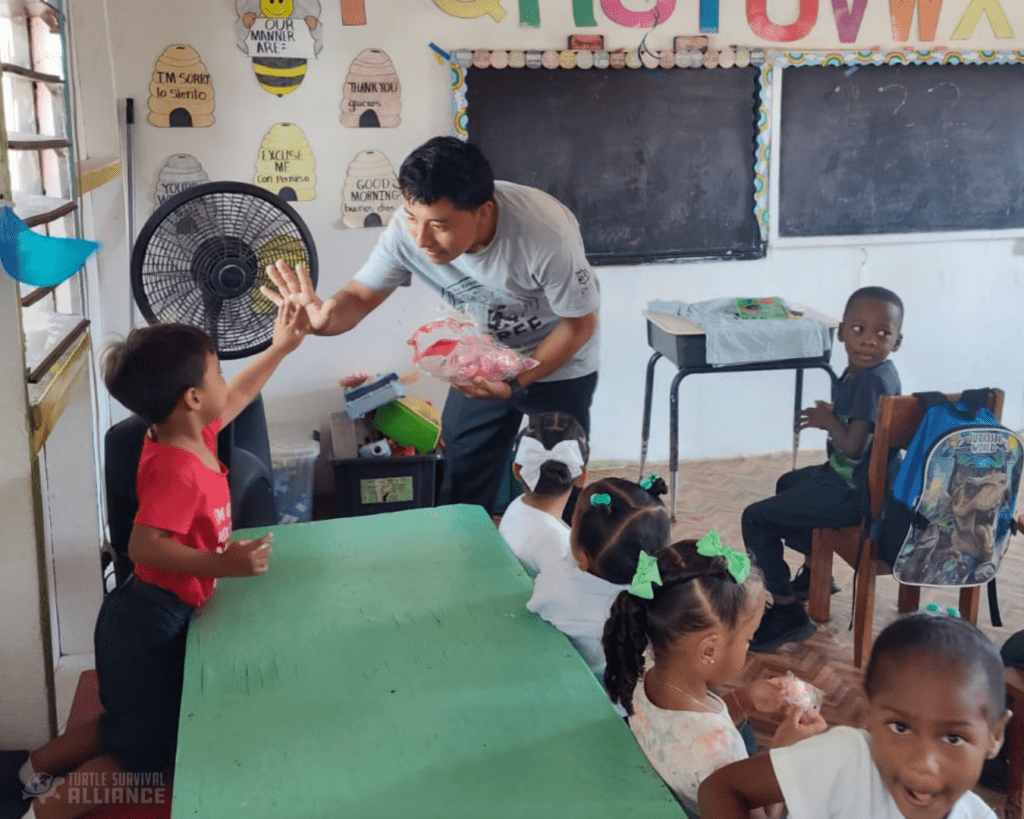
RH: When you are spreading awareness to young students in the community, what’s your favorite way to engage them in turtle conservation?
HC: When it comes to really young students, I try my best to make very engaging presentations, giving more than enough room for kids to interact while at the same time learning something new.
AC: My experiences with young students have been fascinating! Rather than just talking to them about turtles, I prefer to make the learning experience interactive and fun. I often read a story related to turtles or conservation, which captures their attention and imagination. Another favorite approach is organizing a mini coloring competition among their classmates. This not only taps into their creativity but also helps them develop listening and competitive skills. By engaging them through activities they enjoy, they are more likely to connect with the message. It allows them to understand the importance of turtles in their environment and how they can contribute to protecting them in a meaningful way. At the end of the presentations, a lot of them would ask if I would be coming back soon, and that gives me a positive feeling!
SY: One of my favorite ways to engage young students in turtle conservation is by making the experience interactive and relatable, as I did recently during a presentation to a Standard One class in Orange Walk. The students, aged seven to nine, were incredibly receptive and eager to learn. I tailored the presentation to their level, making sure they could easily understand the key points about turtle conservation. What made it special was how enthusiastic they were to share their own stories and experiences with turtles, which made the session feel more like a conversation than a lecture. At the end, we took pictures and videos, and it was amazing to see how thrilled they were with the new knowledge they had gained. It was truly rewarding to witness their openness and curiosity about conservation efforts in Belize.
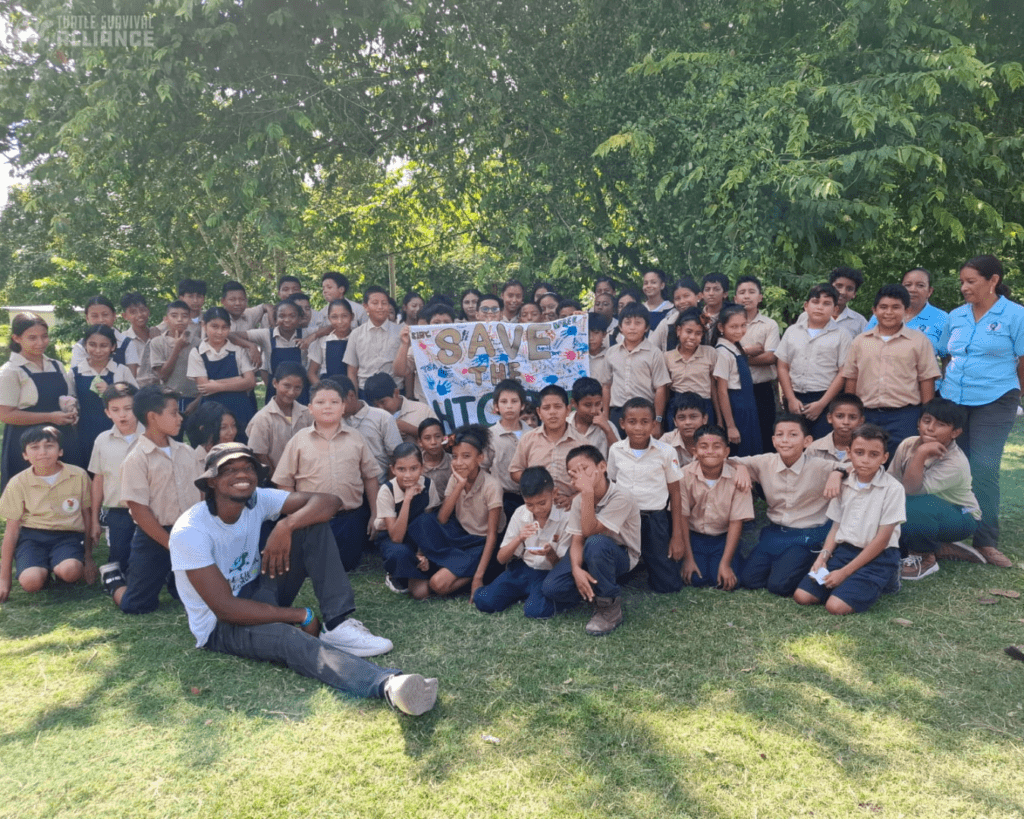
- RH: What is one of your hopes for your future in conservation?
HC: I would want to grow my knowledge enough about the environment and different aspects of nature itself, because I like educating people about these things. Not necessarily as a professor or a teacher, but I want to keep doing what I’ve been doing out here, exploring, learning about animals and plants, and just keep being in nature; and I would want everyone to see it too, so maybe I’d become an environmental influencer or something around that end. Wherever my path takes me, I want and plan to put my efforts towards conservation.
AC: My greatest hope for the future of my work in conservation is to build a strong reputation among nature enthusiasts and experts. I continuously set new aspirations and actively engage with organizations dedicated to protecting Belize’s rich biodiversity. Through this involvement, I aim to gain valuable knowledge, hands-on experience, and a focused mindset, fully aware that the journey ahead won’t be easy. Our world faces many challenges, but I believe if one person can inspire hundreds, then millions can rally to protect Mother Nature. I strive to be that person, always putting God first in everything I do.
SY: One of my hopes for the future of my career in conservation is to be as active as possible in safeguarding the rich biodiversity of Belize. While I’m unsure where my journey will take me, I am committed to working in conservation, as I believe in the importance of protecting our country’s incredible natural resources. Belize is a beautiful place filled with unique ecosystems that need our protection. I recognize that one person alone cannot make a significant impact, but by collaborating with other conservationists and like-minded individuals, I believe we can drive meaningful change in Belize. That is my ultimate hope for the future.
RH: What does it mean to you to be a Hicatee Hero?
HC: I think being a hicatee hero has to come from within. To me being a Hicatee Hero means fulfilling a sense of duty, not only for these turtles but for the sake of our future as well. There is more than meets the eye when you place a turtle back in the water; it’s the feeling you get knowing that you CAN do something for that turtle, the feeling that you not only give that turtle a second chance at life but also hope for their future. I think hope is the best way to describe what it means to be a hicatee hero.
AC: Being a Hicatee Hero means playing an active role in the protection and survival of an endangered species that is vital to Belize’s ecosystems. It’s about raising awareness, educating others, and inspiring change in how we treat the environment. For me, it’s a responsibility to help ensure that future generations will still have the chance to know the Hicatee turtle and its importance. It’s both an honor and a commitment to work towards preserving a species that often goes unnoticed but plays a critical role in our natural world.
SY: Being a Hicatee Hero means recognizing the challenges that this species faces and actively committing to spreading awareness and contributing in any way possible to ensure its survival. It embodies a sense of ownership among community members and emphasizes the importance of citizen science in Belize. As a Hicatee Hero, you become part of a collective effort to protect this vital species, fostering a deeper connection to our natural heritage and inspiring others to join in the conservation movement.
